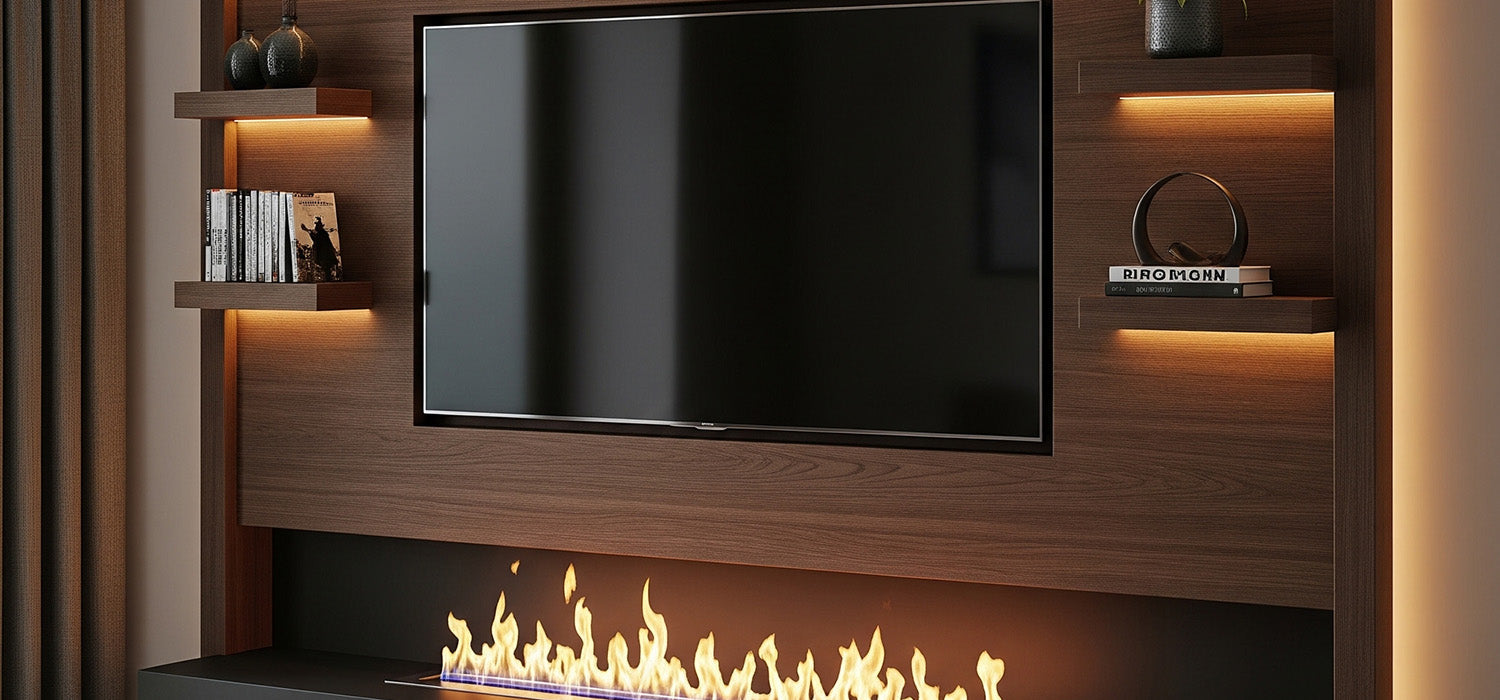
How to Build a Media Wall Backboard for a Sleek TV Setup
Tired of your TV floating awkwardly on a plain wall? A media wall backboard is the stylish fix you need. It hides wires, boosts wow-factor, and pairs perfectly with a Media Wall Fire.
Short answer: it’s form and function. Stick around for clever ideas, tips, and fiery inspiration.
What Is a Media Wall Backboard and Why Is It Essential?
If you’ve ever seen a TV wall that looks like it belongs in a showroom, chances are it’s got a hidden hero behind the scenes—a solid backboard.
A backboard is the sturdy panel installed behind a wall-mounted TV. It gives structure, strength, and design cohesion to the media wall setup. It’s not just about holding the telly—it’s about making the whole thing feel intentional.
Let’s take a closer look at what makes it such a game-changer.
Purpose and Function
Providing Solid Mounting for TVs and Heavy Objects
Think of your TV like a picture. Without a frame, it floats awkwardly and looks unfinished. A backboard is that frame—but for function too.
It creates a strong surface where brackets, soundbars, shelves, and even an electric fire can be mounted safely.
Distributing Weight Evenly
A media wall isn’t just decorative—it carries weight. Quite literally.
Instead of relying on a few wall fixings, a proper backboard spreads the load across a wider area. That means less stress on your walls and fewer worries about things coming loose over time.
Creating a Flat, Stable Surface
Walls are rarely perfect. Between old plaster, uneven surfaces and minor bulges, it can be tough to mount a TV flush to the wall.
A backboard gives you a clean slate—flat, even, and stable. And that makes all the difference when you want a crisp, modern finish.
Why Standard Drywall Isn’t Enough
Lack of Structural Integrity for Heavy Loads
Here’s the thing about standard plasterboard: it’s not made to hold much.
Hang a picture frame? Sure. Support a 60-inch screen and a Media Wall Fire beneath it? Not a chance.
Without a solid backboard, you're relying on hollow wall fixings or chasing cables into the wall itself—both of which can lead to a DIY disaster.
Benefits Beyond Security
Easier Future TV Upgrades
TVs don’t stay the same size for long. A few years from now, that 55-inch screen might feel small.
Installing a strong backboard now gives you the flexibility to upgrade later, without needing to tear down or rebuild the entire wall.
Enhanced Cable Management Opportunities
Nothing ruins a sleek design faster than visible wires dangling down the wall.
Backboards allow you to pre-plan cable routes, cut pass-through holes, and keep things neatly tucked away. It’s the clean, modern look—without chasing into solid walls or skirting around sockets.
Choosing the Right Material for Your Media Wall Backboard
Not all boards are equal. Some are strong. Some are sleek. Some are just plain wrong.
Here’s how to pick the right one for your setup.
Plywood: Strong and Reliable
Thickness Recommendations
If strength is your top priority, plywood is the go-to. It’s sturdy, widely available, and relatively easy to work with.
Aim for 18mm thickness (around three-quarters of an inch) to ensure it can handle the weight of a large TV and any extras.
Grades and Types of Plywood
Use cabinet-grade or construction-grade for a smooth finish and consistent strength. Cheaper options might warp over time—and no one wants a wobbly wall six months in.
MDF: Sleek Finishes for Lighter Setups
Suitability for Finishing
MDF is brilliant for painted finishes or feature walls. It's smooth, easy to paint, and gives a refined surface for decorative effects.
It works well if your TV isn’t too heavy and you’re after a seamless, built-in look.
Considerations for Weight Bearing
That said, MDF isn’t quite as tough as plywood. If you’re mounting something bulky—especially a pull-out bracket or fireplace—make sure it's reinforced.
OSB: Tough and Budget-Friendly
Oriented Strand Board isn’t the prettiest, but it’s tough as nails.
It’s often used in construction for subflooring and sheathing, so it’ll definitely hold a TV. Just know you’ll probably want to cover it—it's not known for its good looks.
Specialised Reinforcement Panels
If you're working with a modular system or a professional installer, you might be offered pre-made reinforcement panels.
These are great for fast installs and often come pre-drilled, saving time and effort. They're ideal for commercial builds or when consistency matters.
Planning and Measuring for Your Media Wall Backboard
Before you start cutting and drilling, it's time to get out the tape measure.
Determining TV Size and Mount Type
Fixed, Tilting or Full-Motion Mounts
Will your screen stay flush, tilt slightly, or swing out on an arm?
Different brackets require different space behind the wall. Make sure you know what you’re working with so your backboard leaves enough clearance.
Identifying Stud Locations
Essential for a Secure Fix
Use a stud detector to map where your wall studs are. You’ll need them to anchor your backboard securely.
Miss the studs, and your fixings won’t hold long. It’s like hanging a coat on a curtain.
Deciding on Backboard Dimensions
Extending Beyond the Mount
Don’t just measure the TV size—go bigger. A backboard that extends above and to the sides gives you room for style and structure.
Future-Proofing for Larger TVs
You may not need it today, but tomorrow? That extra width and height gives you space for a larger screen, soundbar, or even shelving.
Step-by-Step Installation of a Media Wall Backboard
Now for the practical part—how to actually put it up.
Marking and Cutting the Material
Measure your space. Check it twice. Mark your cuts clearly.
This is your foundation, so take your time and get it right.
Attaching to Wall Studs
Screws and Fasteners
Use wood screws long enough to sink deep into the studs. 60–80mm should do the trick.
Keeping It Level
Get your spirit level out. Even a small tilt will be obvious once the TV’s mounted. Shim if necessary, but don’t rush it.
Cable Management Pass-Throughs
Cutting Openings for Cables
Plan where your power, HDMI, and aerial cables will go. Drill neat holes or cut cable slots, and fit grommets if you're feeling fancy.
This step makes a huge difference once everything’s mounted.
Finishing the Backboard
Paint, Panelling or Plasterboard
If your backboard will be visible, sand it down and give it a couple of coats of paint or install decorative slats. If it’s going behind a finish, just make sure it's flush and sealed.
Common Mistakes to Avoid
Not Locating Studs Properly
Guesswork is not a strategy. Use a stud finder, or you might end up fixing into fresh air.
Using Thin or Weak Materials
A 9mm sheet of MDF won’t cut it. Stick with 18mm boards to keep your setup safe and sound.
Skipping Cable Planning
Once it’s up, cutting cable holes becomes a faff. Think ahead—you’ll thank yourself later.
Building a Stronger Media Wall, the Right Way
A media wall backboard might be hidden, but its impact is massive.
It lets you mount your TV, add a Media Wall Fire, and style the space with confidence—knowing it’s all backed by solid structure.
Get the board right, and everything else just falls into place.
Other content we think you'll love
- Bedroom Media Wall Ideas: Create a Stylish & Cosy Retreat
- Corner Media Wall Ideas: Smart Design for Tricky Spaces
- How to Build a Media Wall Over Carpet Safely and Securely
- Black Media Wall Ideas for Bold & Stylish Living Spaces
- Media Wall Cladding: Add Texture, Style and Wow Factor
- Media Wall Covering: Stylish Finishes to Elevate Your Space
- Media Wall Construction: How to Build the Ultimate Feature Wall

